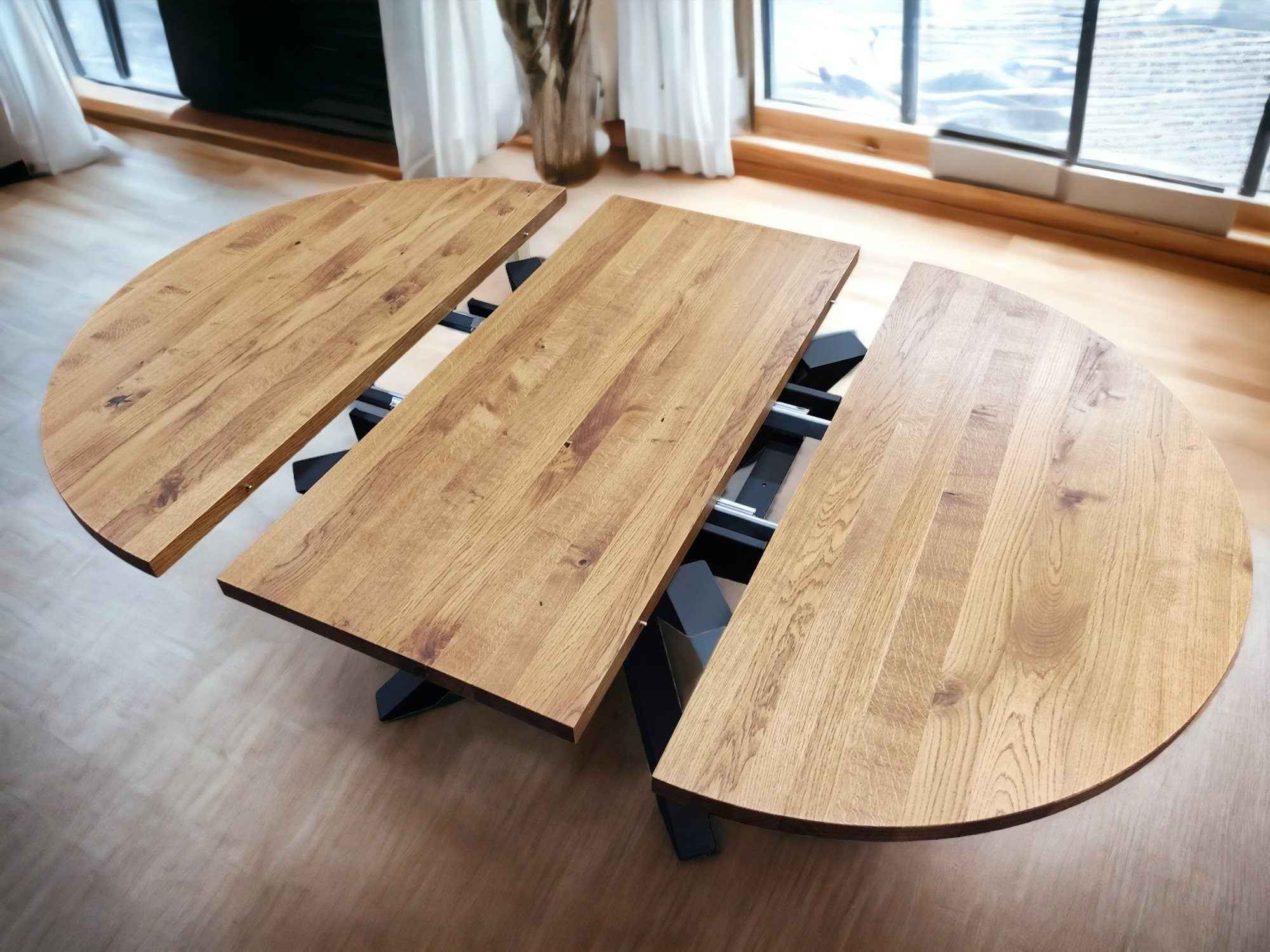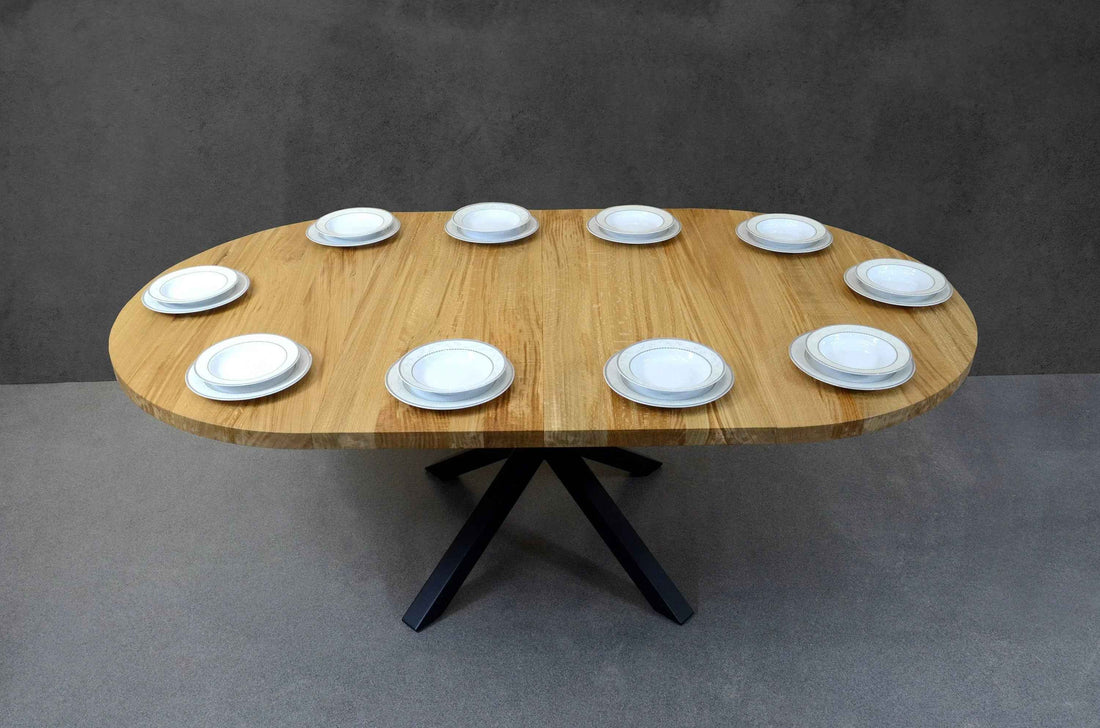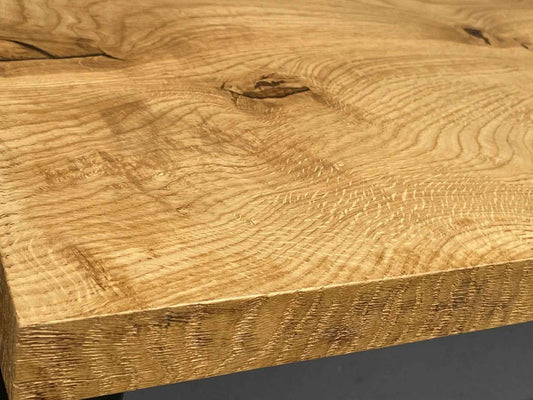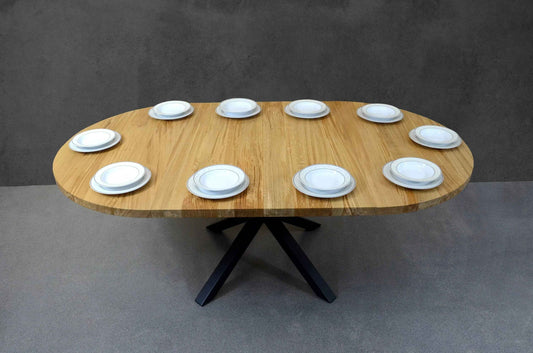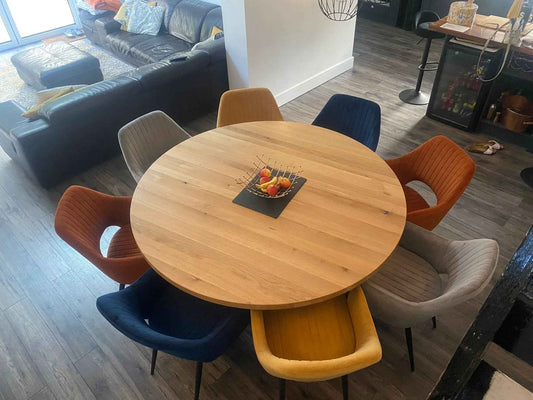1. Table Shape: How to Match It to Your Room Layout?
The shape of the table affects not only the aesthetics of the interior but also its ergonomics:
-
Round tables work perfectly in spaces with limited room. The lack of corners allows chairs to be easily tucked in and encourages comfortable face-to-face conversations. It’s an ideal option for families who value close contact and a cosy atmosphere.
-
Oval tables are a great compromise for those who seek a balance between soft lines and a larger usable surface. Their shape is ideal for more spacious interiors, offering comfortable access to seating. Extendable round tables that transform into an oval shape are also an excellent choice, combining everyday compactness with the ability to quickly increase tabletop space when needed.
-
Rectangular tables are often chosen for larger dining rooms, where placing a longer tabletop along the wall or in the centre of the room feels natural.
2. Table Size – The Key to Comfort
When choosing the size of the table, it is advisable to follow the rule of around 60 cm of tabletop width per person. Both round and rectangular tables come in a variety of dimensions to suit users’ needs.
Round tables with diameters of:
-
110 cm (expandable to 170 cm) are suitable for 4-6 people,
-
130 cm (expandable to 220 cm) comfortably seat 6-8 people,
-
160 cm (expandable to almost 3 metres in length) are ideal for large families or for those who often host gatherings.
Smaller round tables are perfect for compact spaces, especially if they feature an extendable option that allows for quick expansion when needed.
Similarly, rectangular tables with extension mechanisms can be used in a smaller format daily and extended with additional segments for family gatherings or holidays. This solution offers maximum flexibility in both small and large interiors.
An extendable table, regardless of its shape, provides convenience and the ability to adapt to the dynamically changing needs of the household.
3. Tabletop Material – When to Choose Wood, Glass, or Other Solutions?
The choice of tabletop material affects the table’s aesthetics, functionality, and durability. Here are the most popular options:
-
Solid wood – a reliable choice for those who value naturalness and durability. Wood is resistant to daily use, and its unique grain structure adds warmth and character to the interior. It suits Scandinavian, loft, modern, and classic styles.
-
Glass tops – an option for those seeking a light, modern aesthetic. Glass tables work well in small, bright spaces, where they visually "disappear" and do not overwhelm the interior. However, they require more frequent cleaning and are less resistant to scratches and breakages.
-
Veneers and laminates – suitable for those looking for visually lighter tables or models with more diverse colours and patterns. Veneer provides an elegant effect at a lower price than solid wood, but it is generally less durable and more susceptible to damage from moisture and impacts. Laminates are stain-resistant and easy to clean; however, they lack the natural texture and warmth of real wood and can show signs of wear over time, especially on the edges and corners.
If durability and longevity are your priority, solid wood tables – especially those made from oak – are the best choice. They combine natural strength with the beauty of real wood grain, offering a long-lasting investment that maintains its value and character over the years.
4. Table Legs – Functionality in Detail
The construction of the table legs greatly affects not only the appearance of the table but also its practicality and user comfort. Choosing the right type of legs should be tailored to the room size, the number of seats, and the interior style.
-
X-shaped / Crossed legs – a dynamic form of crossed legs under the tabletop, providing excellent stability. These are most often made of metal, emphasising a modern, industrial character, though wooden versions are also available. Their open structure offers ample legroom and gives the table a visual lightness. Perfect for loft, modern, and eclectic interiors.
-
Central pedestal base – ideal for round and oval tables, offering full freedom to place chairs on all sides. This is a perfect solution for smaller spaces where every centimetre counts.
-
Simple, solid wooden legs – a classic choice suitable for both traditional and modern interiors. These legs emphasise the table's solidity and pair well with natural materials. They look great in classic, rustic, and Scandinavian arrangements.
-
U-shaped / Frame base legs – minimalist, geometric forms mainly used in rectangular and large tables. The construction can take the form of individual U-shaped legs or a full frame running under the table. This solution provides high stability and allows for convenient chair placement on the sides. Ideal for spacious, modern dining rooms, lofts, and industrial settings.
Choosing the right type of legs not only helps achieve the desired visual effect but also increases everyday comfort.
5. Table Colour – How to Match the Shade to Your Interior?
The colour of the table significantly impacts the interior's character and visual perception. Light, natural, or dark finishes – each will suit a different decorative context.
Light tables bring brightness and freshness to the interior. Bleached wood shades, sandy tones, or light beiges optically enlarge the space, making them ideal for smaller dining rooms or interiors emphasising minimalist, Scandinavian style. They also fit boho and japandi arrangements, where naturalness and subtle elegance dominate.
Tables in natural wood tones are a timeless classic that works in almost every style. Golden and honey wood shades pair beautifully with both light and dark accessories. Such tables add warmth and harmony to interiors – fitting traditional designs as well as modern, raw spaces where wood balances industrial materials.
Dark tables, especially with black tops, add expressiveness and elegance to interiors. Black highlights the luxurious character of the space, becoming a focal point. A dark table looks great in spacious, well-lit dining rooms, in styles such as modern classic, japandi, or industrial. This is a choice for those who want the table to be a centrepiece of the arrangement.
One should not forget about the colour of the table legs, which significantly influences the final appearance of the furniture. Popular finishes include matt black, white, or anthracite, which harmoniously blend with both light and dark tabletops. These colours bring visual balance without distracting from the beauty of the wood.
In modern arrangements, it is worth considering bold leg colours, such as deep navy, bottle green, or warm shades of copper and gold. These accents can become standout elements of the interior, especially in minimalist spaces where details play a key role.
When choosing the colour of the legs, maintaining consistency with the tabletop is essential – contrasting combinations (e.g., light top with dark legs) will add expressiveness, while similar tones will create a harmonious and elegant whole.
It is also important to remember that not every material allows for full freedom in customising the table’s colour. This is where solid oak tables have a significant advantage.
Oak tops can be finished in many ways – from light, almost bleached tones to classic natural shades and deep black, all while beautifully showcasing the wood's grain. Using high-quality oils and stains, you can achieve colour effects tailored to various interior styles without losing what is most valuable in wood – its natural grain and texture.
This makes oak an extremely versatile material, allowing for aesthetic personalisation while maintaining durability and noble character.
